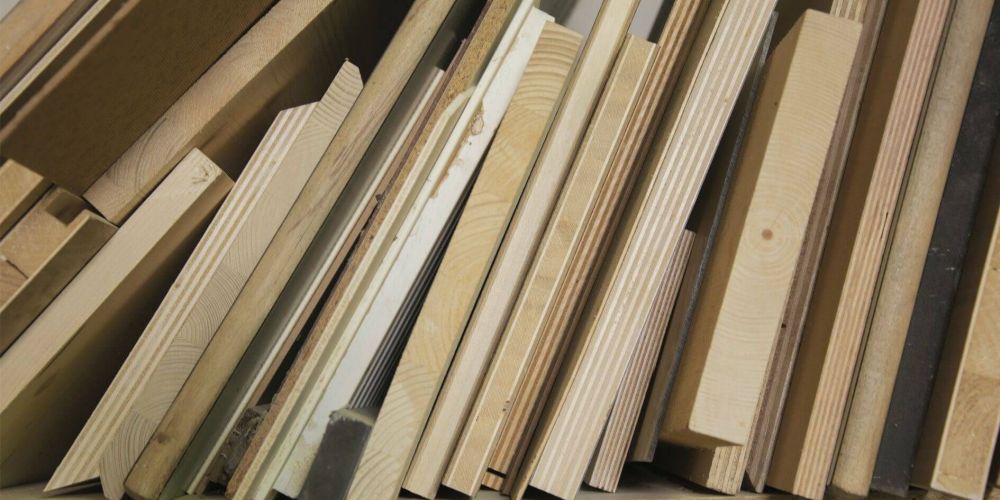When it comes to choosing materials for DIY projects and furniture building, two of the most common options are MDF (medium-density fibreboard) and plywood. But which one should you use? In this article, we'll compare MDF and plywood in the UK, looking at the advantages and disadvantages of each to help you decide which is better for your specific project.
Key features
| Question | MDF | Plywood |
|---|---|---|
| What is it made of? | MDF is made from wood fibres that have been broken down and combined with wax and resin. | Plywood is made from thin sheets of wood that have been glued together with alternating grain directions. |
| What are its strengths? | MDF is strong, smooth, and easy to work with. It is also moisture-resistant and can be painted or stained. | Plywood is strong, durable, and versatile. It is also moisture-resistant and can be used for a variety of applications, including furniture, flooring, and cabinetry. |
| What are its weaknesses? | MDF is not as strong as plywood and can be damaged by moisture if not properly sealed. | Plywood can be more expensive than MDF and can be difficult to work with if it is not properly supported. |
| What is it typically used for? | MDF is typically used for furniture, cabinetry, and shelving. It is also used for acoustic wall panelling and soundproofing. | Plywood is typically used for furniture, flooring, and cabinetry. It is also used for roofing, siding, and subflooring. |
| Is it heavy? | Yes, MDF is heavier than plywood. | Plywood is lighter than MDF, but the weight can vary depending on the type of plywood. |
| Is it waterproof? | MDF is not waterproof, but it is moisture-resistant if it is properly sealed. | Plywood is moisture-resistant, but it is not waterproof. It is important to seal plywood if it will be exposed to moisture. |
| Is it expensive? | MDF is generally less expensive than plywood. | Plywood can be more expensive than MDF, but the price can vary depending on the type of plywood. |
What is MDF?
MDF stands for medium-density fibreboard. It is an engineered wood sheet made by breaking down hardwood and softwood residues into wood fibres. Those fibres are then combined with wax and resin binders and formed into panels under high temperatures and pressure.
The result is a smooth, consistent material with no knots or grain patterns. MDF has a uniform density and structure throughout and is available in a variety of thicknesses, typically from 3mm to 25mm. It can be worked and machined easily with conventional woodworking tools and takes paint and varnish well.
Advantages of MDF
- Affordable - MDF is generally cheaper than natural wood or plywood. This makes it a budget-friendly choice for many projects.
- Consistent - The lack of knots and grain patterns means MDF has a uniform appearance and structure. This makes it ideal when an even, smooth surface is desired.
- Stable - MDF is less prone to warping and expansion/contraction issues compared to natural woods. It maintains its shape well over time.
- Workable - MDF is easy to cut, drill, join and finish using standard tools and techniques. Its smooth surface also takes paints and varnishes nicely.
- Versatile - Available in a range of thicknesses, MDF can be used for everything from furniture to cabinetry, flooring, decor and more.
Disadvantages of MDF
- Not moisture resistant - Most MDF sheets swell and lose structural integrity if exposed to prolonged moisture. It is unsuitable for outdoor use or wet areas unless working with a specifically moisture-resistant MDF board.
- Heavy - MDF is heavier than plywood. This makes it more difficult to work with and can increase shipping costs.
- Contains formaldehyde - The resins used in MDF production contain formaldehyde, which is a known irritant and possible carcinogen. MDF should be used in well-ventilated areas.
- Can sag - MDF's uniform density means it lacks the crossed grain layers that provide plywood's stiffness. MDF shelves and horizontal surfaces may sag over time.
- Harder to finish - The fibres and resins in MDF don't take stain as well as natural wood. Fillers and specialized techniques may be needed for staining MDF.
What is Plywood?
Plywood is made up of thin sheets of wood, called plies or veneers, glued together in alternating directions. The grain of each ply runs perpendicular to the ply adjacent to it.
The most common types of plywood are made from softwoods like pine, larch or spruce. Birch plywood is a popular hardwood option. High-quality plywood uses defect-free veneers without knots or patches. Cheaper versions have repair patches and gaps filled during manufacturing.
Plywood comes in a range of thicknesses, typically from 3mm to 25mm, and a variety of finishes. It can be used for furniture, flooring, decoration, packing crates or in building construction.
Advantages of Plywood
- Strong and stable - The crossed layers give plywood excellent strength, stiffness and resistance to cracking and warping. This makes it suitable for heavy-duty structural and load-bearing applications, especially when using a hardwood plywood grade.
- Workable - Plywood can be machined and finished with ordinary woodworking tools. The layered construction reduces chipping, unlike solid wood which can splinter easily.
- Moisture resistant - The glues used in exterior plywood can withstand wet conditions and intermittent water exposure better than MDF.
- Lightweight - Plywood weighs less than MDF for panels of the same thickness and size. This makes it easier to transport and work with.
- Attractive - Plywood shows attractive layered patterns on the edges. Higher grades used in furniture feature attractive wood grain and figures on the faces.
Disadvantages of Plywood
- Cost - Good quality plywood is generally more expensive than basic MDF, particularly for appearance grades with handsome faces and backs.
- Inconsistent - There may be gaps, knots and patches visible, depending on the grade and appearance level, making consistency and smoothness lower compared to MDF.
- Weaker edges - The edges of plywood are prone to damage while handling and transporting. This can be avoided by applying edge banding for protection, and to improve appearance.
- Unsuitable for some uses - Plywood is not recommended for extensive machining or applications requiring screw retention strength. The layered construction is weaker than solid wood for edge-on fastening.
- Prone to delamination - Plywood can separate at the plies over time, especially when exposed to moisture. Avoid using damaged or delaminated panels, and if you plan to use it outdoors or in humid conditions, opt for a marine plywood board.
MDF vs. Plywood: Which Should You Choose?
So now that you know the main differences between MDF and plywood, how do you choose which one is right for your project?
The bottom line is that the type of project you're undertaking will guide your decision on which of the two sheet materials to use. Here's our advice when deciding:
- For visible surfaces and furniture - Plywood generally provides a more attractive finish, making it a suitable furniture board. Its layered grain and wood texture give a sense of quality. Standard MDF would need to be painted to achieve a comparable appearance. Alternatively, you could opt for a veneered or melamine sheet.
- For hidden surfaces and structures - MDF is ideal for surfaces that will be covered or painted. Its smooth, economical finish keeps costs down for unseen areas like cabinet carcasses.
- For moisture resistance - Plywood's glued layers offer better moisture resistance compared to MDF. Plywood is the better choice for outdoor projects, bathroom vanities, and other areas with increased moisture exposure.
- For large flat surfaces - MDF resists warping across wide surfaces better than plywood. Its uniform density is ideal for worktops, shelving, table tops and desk surfaces.
- For curved and shaped objects - Both plywood and MDF can be bent and shaped when thin sheets are used. MDF holds detail and smooth curves better. Plywood tends to bounce back and resist curved shapes.
- For strength and stiffness - Plywood's layered construction makes it the winner for load-bearing furniture frames, flooring and structural uses that require strength and stiffness.
- For edge finishing - Plywood has the advantage of visible edges. Its attractive plies create natural edge banding effects. MDF edges would need to be faced with solid wood or edging tape.
The optimal choice depends on the specifics of your project and the priorities regarding budget, appearance, features and performance. Consider the strengths of each material and how they align with your goals for the finished piece.
In summary, MDF offers affordability and workability for concealed surfaces and decorative projects. Plywood provides strength, moisture resistance and an attractive wood finish for visible furniture and fixtures. We can provide you with test samples to compare the machining, finishing and handling characteristics before committing to full sheets. An informed choice matching the sheet material to your needs will lead to better project results.




